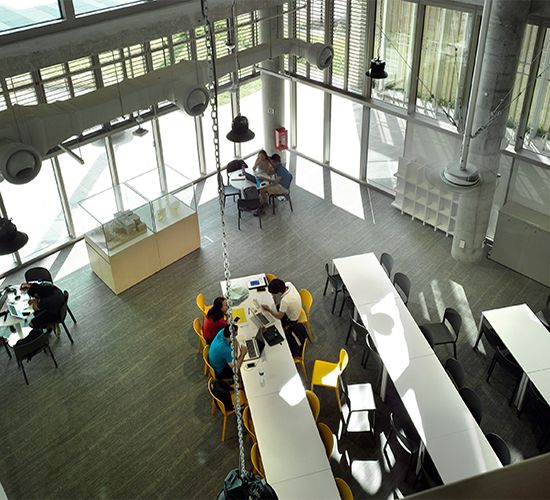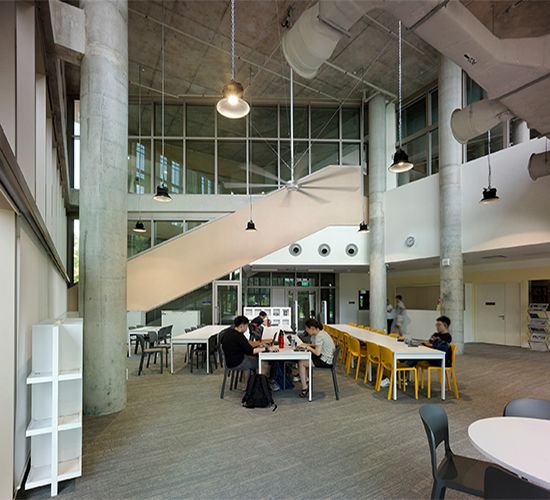Located within the National University of Singapore (NUS) School of Design and Environment, Singapore’s first new-build net-zero energy building, SDE4, is a living embodiment of sustainable and human-centric design. Designed by Serie+Multiply Consultants with Surbana Jurong, the building epitomises our Live Zero principles by demonstrating how to leverage biophilic, low-carbon design to enhance comfort and wellness in a tropical climate.
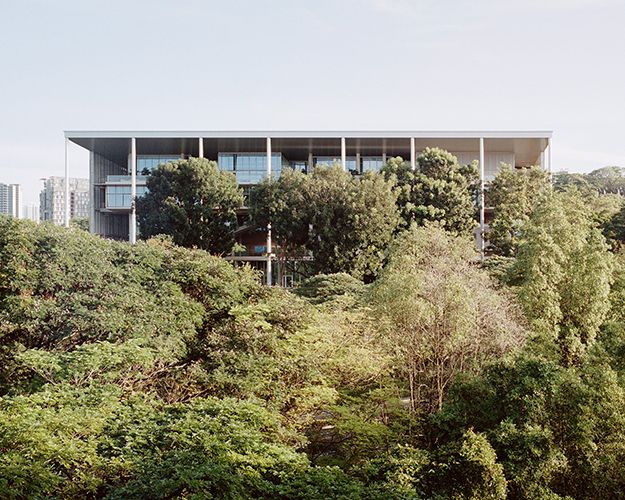
SDE4’s south elevation. Photograph by Rory Gardiner.
Professor Lam Khee Poh, Dean of the NUS School of Design and Environment, said, “The successful completion of SDE4 demonstrates that stringent energy targets for buildings in the tropics are achievable.”
“Through a well-executed integrated design process, the building will also provide a comfortable and biophilic experience coupled with a low carbon footprint.”
SDE4’s shallow plan depth and porous layout allows for generous natural ventilation and lighting. Working with double facades on two sides of the block, its large overhanging roof helps to keep the interior cool. And its cutting-edge hybrid cooling system ensures that each room is supplied with 100% fresh air, cooled at slightly warmer and more humid levels than that from conventional air-conditioning systems – making for an incredibly comfortable environment.
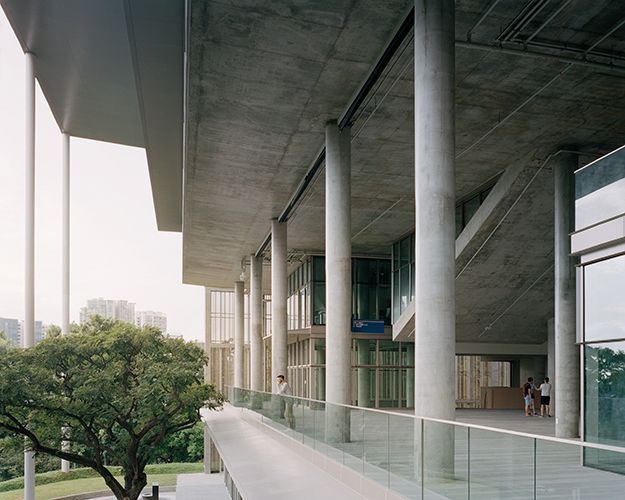
A view from SDE4’s Social Plaza. Photograph by Rory Gardiner.
Atop the building’s roof are 1,200 photovoltaic panels, hard at work absorbing the sun’s rays.
The net effect is a design school that can accommodate more than 500 students and staff, built to consume only as much energy as it produces.
Lam explained, “We can expound great theories and great strategies through our lectures and seminars, but at the end of the day, our students’ first-hand experience is equally important when it comes to supporting theory with practice.”
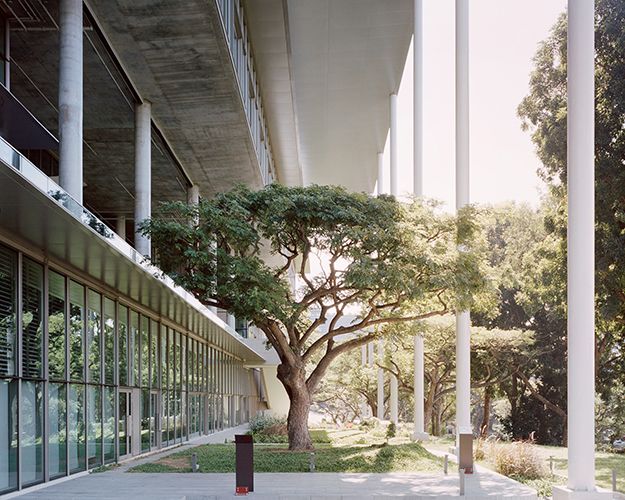
A tropical portico. Photograph by Rory Gardiner.
This is also why the School paid particular attention to the selection of materials, choosing Interface’s Carbon Neutral Floors™ for its Information Resource Centre (IRC) and Executive Rooms – stunning examples of great design helping people to work smarter.
Stepping into the IRC, a soothing tropical breeze from the silently rotating ceiling fans washes over you. The room’s lengthy glass panels draw nature into the space, making you feel like you are in the middle of a garden.
Your eyes are drawn to the sunlight streaming in through the windows and landing on the soothing cool griege of the floors. Inspired by the natural coastline, Interface’s East Coast range re-creates the organic shapes of the water and sand as waves crash upon the shore – random, layered and multi-directional.
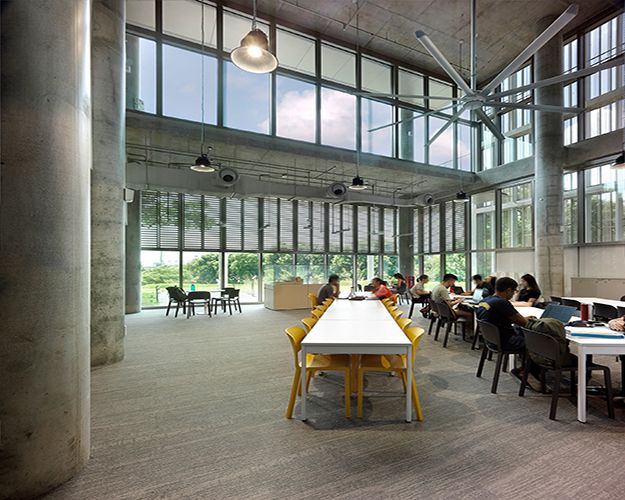
Interface’s East Coast in SDE4’s Information Resource Centre.
According to Chris Lee, Design Architect at Serie + Multiply, “one of the key features of SDE4 is the deliberate use and celebration of the raw and natural characteristics of the materials.”
This ethos is echoed everywhere else in the building – most noticeably in the natural textures of its towering concrete pillars.
“We left [the materials] as raw, delicate, and as true as possible,” Lee said.
Every Interface product including East Coast is 100% carbon neutral – all at no extra cost to customers. It’s another key step towards Climate Take Back™, our mission to run our business in a way that reverses global warming.
We’ve achieved this by reducing our carbon footprint by over 60% since 1994 and balancing what we still can’t avoid with carbon offsets that support renewable energy, fuel switching and reforestation to keep carbon in nature and out of the atmosphere. By specifying Carbon Neutral Floors™, the School contributed to the retirement of an amount of carbon equivalent to the greenhouse gas emissions from a car travelling 20,586 kilometres.
Perhaps the most outstanding feature of the School is that it came with a negligible extra cost compared to similar, industry-standard models. “The building has…demystified the general perception of cost for sustainable buildings…SDE4 changes the argument that green buildings cost more,” said Giovanni Cossu, Senior Manager of the NUS School of Design and Environment.
SDE4 has been awarded the Green Mark Platinum certification and will be the first building at the NUS to be certified under the WELL Building Standard. Among other steps, the School used good construction practices such as choosing materials with low VOC content and storing fabrics like carpets in specially designated areas.
Dr Nirmal Kishnani, Former Vice Dean (Special Projects) of the NUS School of Design and Environment, told us about next steps for the School now that SDE4 has officially opened.
“There is a bigger challenge ahead, and this is how this building is put to use. We have to educate the users; we have to excite them. We have to prepare them for how this building is going to perform and how they must interact with it.”
“This is a really important part of the process that we’ve been discussing; it is a closing of the loop from drawing board to use.”
While two buildings in the School are currently being renovated, a third will be redeveloped as a net-positive energy, net-zero water, wellness-certified and low-carbon facility.
Kudos to the School for designing with the climate in mind and lowering their carbon footprint with Carbon Neutral Floors™ – and for proving that with smart design, sustainable outcomes don’t cost more. Together, we can take the climate back.
